Understanding and Managing Diabetes Through Nutrition
November is National Diabetes Awareness Month, and with World Diabetes Day on November 14th, there's no better time to focus on how to manage diabetes through nutrition. Living with diabetes requires a thoughtful approach to what you eat, how much you eat, and understanding the impact of different foods on your blood sugar levels. For us in Hawaii, that means making mindful choices while still enjoying the flavors and traditions that make local cuisine so unique. In this guide, we’ll dive into how balanced meals, proper portion sizes, and carb counting can help you take control of your diabetes.
What is Diabetes and Why is Nutrition Important?
Diabetes is a chronic condition that affects how your body processes blood sugar (glucose). There are different types of diabetes, including type 1, type 2, and prediabetes, but the common factor is that the body struggles to regulate blood sugar levels effectively. This can happen due to insulin resistance, not producing enough insulin, or a combination of both.
Good nutrition is a powerful tool in diabetes management. The right dietary choices help stabilize blood sugar levels, maintain a healthy weight, and reduce the risk of complications. This is where thoughtful planning, such as balancing meals, controlling portions, and counting carbohydrates, comes into play.
The Power of Balanced Meals in Diabetes Management
A balanced meal contains a mix of protein, healthy fats, carbohydrates, and fiber. Together, these components help keep blood sugar levels stable, as they are digested at different rates and have varying impacts on your body.
Protein (found in foods like fish, chicken, tofu, and beans) helps keep you full longer and has minimal effect on blood sugar.
Healthy fats (such as avocados, nuts, and olive oil) slow down digestion and provide lasting energy.
Carbohydrates (like bread, rice, fruits, and starchy vegetables) are the body's primary source of energy, but they have the greatest impact on blood sugar.
Fiber (present in whole grains, vegetables, and legumes) helps slow the absorption of sugar, promoting more stable blood sugar levels.
In Hawaii, balancing meals can include enjoying traditional foods like laulau (steamed taro leaves with fish or pork), poke bowls made with brown rice and vegetables, or grilled fish served with a side of poi. The goal is to make mindful choices without losing the flavors you love.
Carb Counting: What It Is and Why It Matters
Carb counting is an essential skill for managing diabetes. Carbohydrates directly impact blood sugar levels, so understanding how much you're consuming can help you make adjustments to maintain stable levels.
To get started with carb counting:
Learn to read nutrition labels for serving sizes and total carbohydrates.
Aim for consistency in the amount of carbs you eat at each meal to prevent large spikes or dips in blood sugar.
Track carbs in traditional Hawaiian foods, like a half cup of poi containing roughly 20 grams of carbs, or a slice of pineapple having about 15 grams.
When dining out, especially when enjoying local favorites like plate lunches, it’s important to be aware of the hidden carbs in rice, macaroni salad, and sweet sauces like teriyaki or katsu sauce. Swapping white rice for brown rice or adding extra veggies can help lower the carb content and boost fiber which helps slow down how fast you digest those carbs.
Portion Control for Better Blood Sugar Management
Eating the right amount of food is just as important as choosing the right types of food. Portion control helps prevent overeating and ensures your meals contain a balance of nutrients. Here are some tips for managing portion sizes:
Use smaller plates to make your portions look larger.
Fill half your plate with non-starchy vegetables, like leafy greens, cabbage, or cucumbers.
Measure your servings of rice, poi, or other starchy foods to limit carbs. A half-cup of cooked brown rice, for example, is about the size of your fist and contains around 22 grams of carbs.
Practicing portion control doesn't mean you have to give up your favorite foods. It’s about finding a balance that keeps your blood sugar levels in check.
Local Diabetes-Friendly Meal Ideas
Here’s a sample meal plan that includes diabetes-friendly foods while incorporating the flavors of Hawaii:
Breakfast
Protein-rich option: Scrambled eggs with 2 tbsp cottage cheese and sautéed spinach
Lower Carb “Sweet” Breakfast: Half of a papaya filled with plain Greek yogurt and a sprinkle of chopped macadamia nuts.
Lunch
Balanced meal: Poke bowl with brown rice, ahi tuna, cucumber, avocado, and nori.
Portion control tip: Keep rice to a half-cup serving and load up on veggies to add volume.
Snack
Fiber-rich option: Handful of baby carrots or a small apple with a tablespoon of almond or peanut butter.
Sweet tooth option: Dark chocolate covered almonds
Dinner
Local flavor: Grilled mahi-mahi topped with macadamia nuts and a side of roasted vegetables (broccoli, bell peppers, and carrots)
Carb-counting idea: Add a half-cup of poi or Okinawan sweet potato for a slower digesting complex carb option
Managing diabetes through nutrition is all about balance and making informed choices. By focusing on balanced meals, practicing carb counting, and being mindful of portion sizes, you can keep your blood sugar levels in check while still enjoying the foods you love. Small changes add up over time, leading to better health and more stable energy.
If you have any questions or need personalized advice, don’t hesitate to reach out to us at A Dash of Nutrition and we can help create a plan that fits your lifestyle and nutritional needs.

